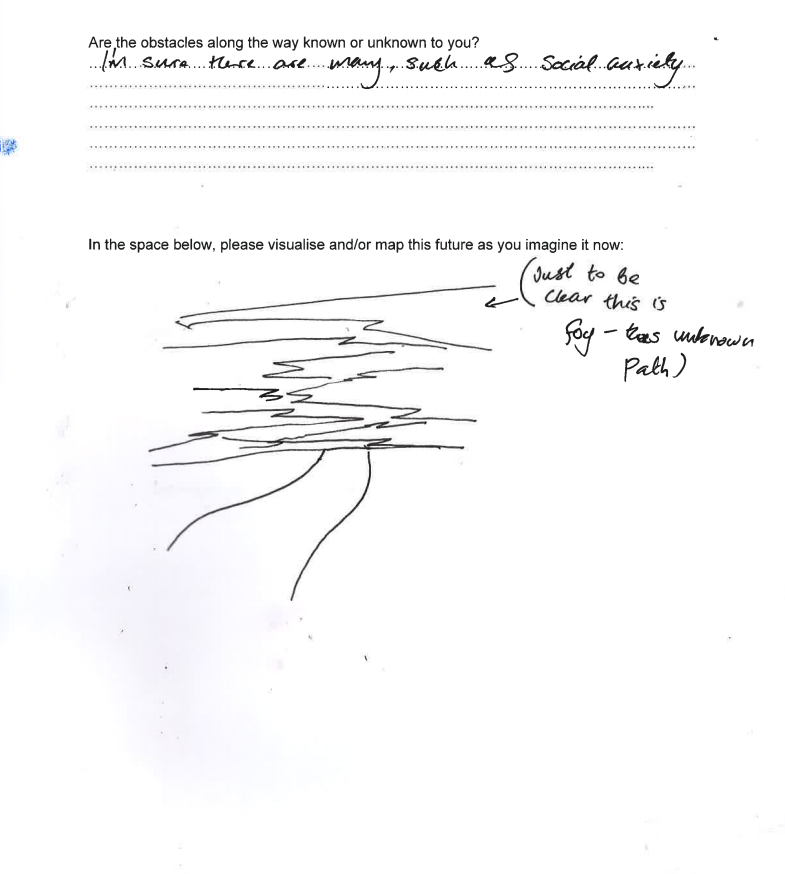Here are some musings I had around the future. It is intriguing to me how futures have this dualism, being at one point something within and outside of our control. The knowledge that there are infinite possible futures can be both empowering and bewildering. But then the notion that our futures are already decided, or not within our power to change, is similarly fraught.


Anxiety is commonly to do with concerns and worries surrounding future events (whether immediate or distant), because of imagined negative predictions. The uncertainty of what will occur in future events means that we all predict to some extent what to expect in order for us to effectively plan for that event, whether our brain is reliably doing so or not is a matter for mental health professionals. But it is intriguing for me this planning and prediction, and fear of the unknown.
I thought it could be interesting to explore this prediction/imagining of the future through some questions posed to my peers, to see how differently they might all be doing so. I chose to create a questionnaire with suitable ambiguous and open-ended questions in order to do so. I also wanted to ensure I was accessing their personal future, rather than a prediction about humanity, which could rely less on their own personal prediction than something they have read elsewhere. So I chose to play with the dual meaning of ‘where are you going’ as in a physical or spiritual location. A destination that can be self-determined by the respondent. Below is an example of a response to my questionnaire.
Recent trends which have addressed this anxiety (which we are told is on the rise) include mindfulness, as well as the popular pursuit of yoga and pilates. These all bring us back to Zen buddhism practices, which I was reflecting on previously.
observation and being seen (how not to be seen video)
I think it could be interesting to create a set of instructions for navigating the unknown. Not only in terms of the map making that I have explored so far with the grid, but also in the other ways we make sense of the world, and how we might go about getting to know the unknown, e.g. stories, histories, signs, rules, rituals etc.
This would of course follow on from the instructional works I saw from Yoko Ono, which I have since discovered was also used by other artists such as Brecht, and more recently there was a collaborative work with various instructions by artists called Do It.
I also saw this fascinating and amusing work by Hito Steyerl called How Not to Be Seen: A Fucking Didactic Educational .Mov File at the Tate Liverpool gallery. It provides a series of instructions for how to avoid being seen, and takes it’s name from the Monty Python sketch.
I find the voiceover particularly fascinating – it reminds me of the robotic voices of assistive AIs such as Siri, but also sounds like it has been distorted or slowed down, slurring. This reinforces the ridiculous nature of the film, which I enjoy.
In a similar vein, I have drafted a set of instructions for navigating unknown spacetimes. The intention is that a person should act out the instructions whenever they find themselves in a place that is unknown that they would like to become familiar with, to help them navigate this anxiety. I have sought to make this similar to the mindfulness meditation exercises commonly shared. For instance, a suggestion on this website is to meditate while washing up:
Savor the feeling of the warm water on your hands, the look of the bubbles, the sounds of the pans clunking on the bottom of the sink.
verywellmind.com
Apparently this form of meditation is proposed by Zen Buddhist monk Thich Nhat Hanh! I love how this everyday experience has been transformed into something transcendental and spiritual from mere instructions on what to focus your attention on. Something so simple but seemingly world-bending, while doing a mundane chore.
Below is a download link to a draft of my instruction leaflet.
I intended to try and cover the different ways humans go about getting to know or make sense of places (indicated by the different chapter titles), and imitating them so that I could create a set of actions that could capture this in miniature, to readily turn an unknown place into one you are well-acquainted, or in fact intimately knowledgeable of. I think this achieves this (though I or some willing participants will need to test it out!). I have also managed to work in my learning about grid cells and how the brain ‘maps’ the world, by including instructions for moving using a hexagonal pattern. What I feel I have lost though from the examples I have looked to, is this sense of humour and nonsense… though some of the actions do seem odd, I don’t think they go as far as to be funny. I like though that the framing of it as for ‘conscious agents’ and ‘spacetimes’ implies for me that it could almost be a future person, or alien person discovering a wholly new place and time, though it remains open to interpretation.


